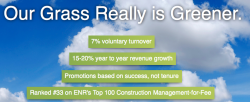 Cumming may have only 255 employees, but its new website looks like one built for a company a bit bigger, all for a budget of a couple hundred bucks. You’ll be disappointed if you want slick career-site pizzazz, but not if you’re happy with fairly clear messages, a simple look, and some symbolic art of a tree with fingerprints.
Cumming may have only 255 employees, but its new website looks like one built for a company a bit bigger, all for a budget of a couple hundred bucks. You’ll be disappointed if you want slick career-site pizzazz, but not if you’re happy with fairly clear messages, a simple look, and some symbolic art of a tree with fingerprints.
Scott Weaver, who manages the four-person talent acquisition team, walked into the marketing department about a year ago with some concerns.
Over a four-year period, there were about 50 percent fewer people applying for jobs. And, on two key statistics the company kept, the results weren’t pretty.
“Here are the stats,” Weaver says. “‘Hireability’ at the end of last year was measured at 1 percent while ‘quality’ was measured at 15 percent. So out of every 100 candidates, only one was hireable on average. Additionally, out of 100 candidates, only 15 were baseline qualified … meaning, they technically matched the industry and years of experience on a job description, but a much smaller percentage of them received a screening call or interview.”
The company’s not huge. But it has projects in more than 25 countries, 15 to 20 percent revenue growth, even higher employee growth, and a very specific niche. “We know exactly who our competitors are, we know exactly who the people who work for our competitors are,” Weaver says.
We’re talking a lot of passive sourcing, headhunting.
“We need to drive better quality to our opportunities, and the company is extremely particular about hiring top-of-the-class A players,” Weaver says.
 What followed was not just a site redesign, but a real re-thinking of the brand — the employment brand. The marketing department, with input from recruiting, came up with some proposed messages, along with graphics. Weaver’s feeling is that marketing is the marketing expert (go figure), not necessarily the recruiting department.
What followed was not just a site redesign, but a real re-thinking of the brand — the employment brand. The marketing department, with input from recruiting, came up with some proposed messages, along with graphics. Weaver’s feeling is that marketing is the marketing expert (go figure), not necessarily the recruiting department.
The goal of these early steps, Weaver says, was to create something “that was a truthful representation of culture, and targeted to the audience.”
The winner was a “make your mark” phrase — which was more than just a phrase; as I said, it’s aimed at encapsulating what Cumming says is good about a job at the company. Everyone has a chance to make a difference, regardless of their years of experience, title, or job. Their ideas matter.
This was early 2013. Developing the brand did take time, staff time. So too did the building of the website that followed. When I talk about the small budget of this project, I’m including just outside vendors, not internal work hours.
The URL’s pretty handy: ccorpcareers.com. This new site includes photos and bios of recruiters as well as information about the hiring process.
It’ll be officially launched soon with a social media campaign, but Weaver and Cumming are still figuring out just what that’ll entail (expect more LinkedIn and Facebook than Twitter). He has a list of about 1,000 employees of competitors, poachable candidates who’ll receive branded messages. So too will “talent community” members. They’ll likely get a monthly newsletter with information about the company like awards, office openings, and jobs open.
Weaver would like to do something more. Maybe it’ll be q-and-a sessions with candidates, for recruiters to answer questions about resumes, or interviewing. Maybe a video contest, where each office will submit a one- to five-minute video about their culture, with the best being spread via social media.
Another idea is a “guess-the-cost” competition. The company provides cost estimates — how much it’ll take to build a hospital, for example — and candidates or community members would play a guessing game that’d be fun, and give them a sense of what the company does.
Says Weaver: “I didn’t want to do branding just because others are.” He wanted the company to do it to increase those percentages mentioned above. “If it’s not working,” he says, “I’m re-evaulating what we’re doing to drive more quality candidates to our opportunities.” He wants hireability over 5 percent and quality of candidate over 20 percent.
During the company’s 2012 recap with the talent acquisition team, it had written down the words “be the best.” Says Weaver, “I can confidently say that we have the best talent acquisition structure in our industry of ‘pure-play’ project and cost management consultancies in the U.S. In the seven years that I’ve been with the company, we’ve paid one external recruiter fee and that had more to do with us being overloaded with reqs than it did with our inability to fill the role.”